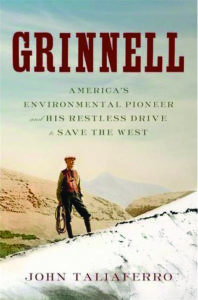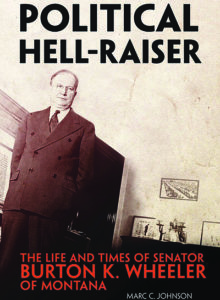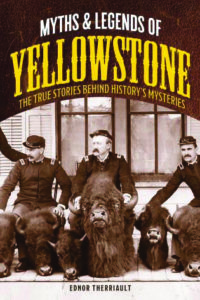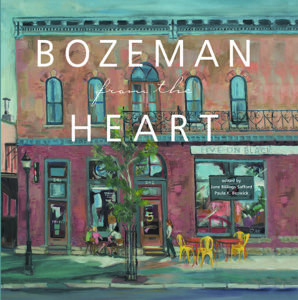Bryce Andrews, John Taliaferro, Marc C. Johnson, Ednor Therriault and others explore Montana’s history, landscape and politicians.
Down From the Mountain: The Life and Death of a Grizzly Bear

In searing detail, award-winning writer, Montana rancher, and conservationist Bryce Andrews tells the story of a grizzly sow, who descends from the Mission Mountains on the Flathead Indian Reservation to seek food for her two cubs. Millie is a typical mother: strong, cunning, fiercely protective of her cubs. But raising those cubs – a challenging task in the best of times – becomes ever harder as the mountains change, the climate warms and people crowd the valleys. There are obvious dangers, like poachers, and subtle ones as well, like the cornfield that draws her out of the foothills and sets her on a path toward trouble and ruin.
The author’s story intersects with Millie’s, and a singular drama evokes a much larger one: an entangled, bloody collision between two species in the modern-day West, where the shrinking wilds force man and bear into ever closer proximity.
“Rife with lyrical precision, first-hand know-how, ursine charisma, and a narrative jujitsu flip that places all empathy with his bears, Down from the Mountain is a one-of-a-kind triumph even here, in the home of Doug Peacock and Douglas Chadwick,” writes David James Duncan, author of The River Why and The Brothers K.
Andrews also wrote the Badluck Way, winner of the Barnes & Noble Discover Award and the Reading the West Book Award; he works with the conservation group People and Carnivores. Listen to him discuss the book on Montana Public Radio’s The Write Question.
Grinnell: America’s Environmental Pioneer and His Restless Drive to Save the West

Before Rachel Carson, there was George Bird Grinnell – the man whose prophetic vision did nothing less than launch American conservation. In a timely biography, John Taliaferro tells his story.
The son of a New York merchant saw a different future for a nation in the thrall of the Industrial Age. With railroads scarring virgin lands and the formerly vast buffalo herds decimated, the country faced a crossroads: Could it pursue Manifest Destiny without destroying its natural bounty and beauty?
One of the most important originators of the American conservation movement, Grinnell founded the first Audubon Society and, with Theodore Roosevelt, the Boone and Crockett Club (which promoted the concept of “fair chase”), helped create Glacier National Park (where a glacier now bears his name) and worked to install legal protections for migratory birds. He was also a highly respected ethnologist who published numerous articles and books including The Cheyenne Indians: Their History and Ways of Life.
In a starred review, Publisher’s Weekly calls the book “an impressive, eminently readable biography … Anyone who’s ever set foot in a national park and wondered how it came to be will find an important part of the answer in this expansive look at an equally expansive life.”
Taliaferro is a graduate of Harvard College, a former senior editor at Newsweek and the author of five previous books. He lives in Montana and Texas.
Political Hell-Raiser: The Life and Times of Senator Burton K. Wheeler of Montana

Burton K. Wheeler (1882-1975) may have been the most powerful politician Montana ever produced, and he was one of the most influential – and controversial – members of the United States Senate during three of the most eventful decades in American history. A New Deal Democrat and lifelong opponent of concentrated power, he consistently acted with a righteous personal and political independence that has all but disappeared from the public sphere.
Wheeler came of political age during World War I amid antiwar and labor unrest in Butte. As a crusading U.S. attorney, he battled Montana’s powerful economic interests, championed farmers and miners, and won election to the U.S. Senate in 1922. There he made his name as one of the “Montana scandalmongers,” uncovering corruption in the Harding and Coolidge administrations.
Drawing on extensive research and new archival sources, journalist Marc C. Johnson gives a thorough telling of the homegrown maverick’s career, including all its accomplishments and contradictions.
“We Americans need a good and true story like this – about a determined lawyer who defended the rights of day laborers in a hard-rock mining camp out west and went on to represent his constituents as their U.S. senator to his final breath,” writes Pat Williams, U.S. Representative from Montana, 1979–1997.
Myths and Legends of Yellowstone: The True Stories Behind History’s Mysteries

The world’s first designated national park, Yellowstone is famous for its steaming geysers, bubbling mud pots, and wildlife-caused traffic jams. But few people may know about the many Native American tribes that visited the area long before John Colter “discovered” it, how one man nearly decimated the park’s bison population, or the strange music that emanates from Yellowstone Lake.
Missoula author Ednor Therriault explores unusual phenomena, strange events, and mysteries in Yellowstone National Park’s history. From rumors of ghosts in the iconic Old Faithful Inn to Bigfoot sightings throughout the park, Myths and Legends of Yellowstone pulls back the curtain on some of this national treasure’s most fascinating and compelling stories.
Relive the grueling trek made by George Cowan, who spent four days dragging his broken body through the park after being shot and stoned by hostile Nez Perce. Read about dangerous amusements once practiced by Yellowstone’s visitors and even park rangers, from feeding bears to “soaping” geysers.
Therriault’s Montana roots run deep: his great-great-grandparents homesteaded on Douglas Creek in the late 1800s. Following his penchant for quirky tales, he has also written Montana Curiosities and Montana Off the Beaten Path for Globe Pequot.
Bozeman from the Heart
Bozeman denizens share their personal stories and histories in this one-of-a-kind compilation, edited by June Billings Safford and Paula K. Beswick, that offers a reflection on why the town and community are so beloved. Original pieces from 25 local writers, actors, musicians, artists and educators are accompanied by June B. Safford’s vibrant paintings of the people and buildings that comprise Main Street and surrounding institutions. Together, this visual and narrative feast offers a heartfelt picture of the people and unique places that make Bozeman so special.
Bozeman from the Heart blends collective memories, hopes for the future, and the contributors’ views of Main Street today. According to the editors, “Bozeman’s undeniable growth has prompted a need to assess our core and take the town’s temperature while it is still possible.”

Readers learn about some of the quirky characters who once called Bozeman home, and others who still do; discover the nascent arts and cultural scene of the 1950s, ’60s and ’70s; and get a hint of the city’s contemporary flavor.
For long-time residents the book nourishes their love for Bozeman and sense of awe; for new residents or those who are visitors, it offers a storied heart-line to introduce the meaning of “I live in Bozeman” from people who do.
Butte and the 1918 Influenza Pandemic (Disaster)
Butte was an incomparable city, but in late 1918, some of the things that made it so exceptional also made it incredibly cruel. That year, the Spanish flu swept across the country, killing some 675,000 Americans before year’s end. Some of the country’s highest mortality rates occurred in its cities – Philadelphia, San Francisco, Boston and Butte.
In less than six months, the virus killed almost 2 percent of Butte’s residents and overwhelmed public health systems. Experimental treatments, civil unrest, death, and human resilience followed in the dramatic final weeks of the year.
Author Janelle Olberding recounts the emotional struggle of the men and women who fought against, suffered from, and succumbed to influenza on the “Richest Hill on Earth.”
The historian and writer says her interest in communicable disease was piqued while working in public health, and she began studying its effects on culture and history as a graduate student at Norwich University. She currently works in higher education and lives in Glendive, with her husband and daughter.
Montana’s Big Hole Valley – Montana Pioneers of the Old West – Vol. I
A new 448-page book, years in the making, recounts the settlement of Montana’s Big Hole Valley from 1806 through 1930.
“From the gate of the Big Hole, Divide, through Dewey, Wise River, Wisdom, Briston, Fox and Jackson, we visit our vibrant communities as well as places no longer here and tell the stories of the many families and individuals who helped settle this historic part of Montana,” said Ruth Nelson Little, president of the Big Hole Valley Historical Society and lead editor of the new book.
The volume includes hundreds of stories of early-day settlers and the struggles they went through to establish a way of life in this high-altitude valley, pressed against the mountainous border with Idaho. Several hundred historic black and white and color photographs also depict the valley historically been known as the “Land of 10,000 Haystacks.”
Chapters also cover such subjects as the Lewis & Clark Expedition’s visit to the upper valley in 1806, the Native American presence in the valley, early explorers, the famous Battle of the Big Hole in 1877 between the U.S. Army and the Nez Perce, mining, trapping, logging, agriculture, family histories and much more.
The book is available from the Big Hole Historical Society at Box 847, Jackson, MT 59736, or from Stoneydale Press, 800-735-7006 or www.stoneydale.com.